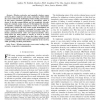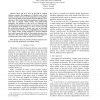1625 search results - page 33 / 325 » Achievable performance improvements provided by cooperative ... |
TWC
2008
14 years 9 months ago
2008
Wireless networks, and especially wireless sensor networks, have complexity and energy constraints, within which they must confront the challenging wireless fading environment. In ...
CONEXT
2008
ACM
14 years 11 months ago
2008
ACM
We consider the problem of improving network capacity in wireless mesh networks from the angle of multi-flow diversity. As consecutive packets on a multihop path can interfere wit...
ICRA
2005
IEEE
15 years 3 months ago
2005
IEEE
— More and more work in the field of artificial olfaction considers the integration of olfaction onto robotic systems. An important part of this integration is providing the ro...
ICC
2008
IEEE
15 years 4 months ago
2008
IEEE
— In a distributed space-time coding scheme, based on the relay channel model, the relay nodes co-operate to linearly process the transmitted signal from the source and forward t...
CORR
2008
Springer
14 years 10 months ago
2008
Springer
In a distributed space-time coding scheme, based on the relay channel model, the relay nodes co-operate to linearly process the transmitted signal from the source and forward them ...


